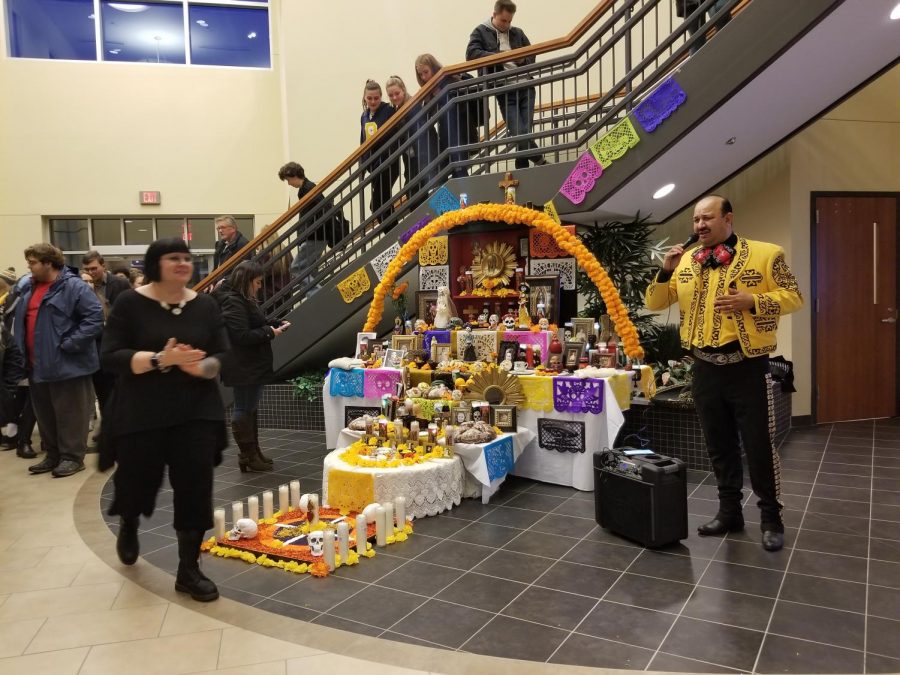GV celebrates Day of the Dead
Artist Bethany Grenier (left) walks by her altar while performer Gabriel Estrada (right) sings to the audience. GVl/Lucas Swartzendruber
Nov 4, 2019
Rather than trick-or-treating this Oct. 31, some students celebrated Day of the Dead with the Latin American and Latino/a Studies program at the Frederik Meijer Honors College.
“We usually do it on Nov. 1, but the problem is Nov. 1 is a Friday,” said David Stark, LAS program coordinator.
Stark mentioned being concerned that many students would not be able to attend Friday night. Therefore, the celebration was rescheduled to Oct. 31. Though Stark noted this meant competing with Halloween, students and others crowded the Honors College lobby, gathering around an ofrenda, which is Spanish for “offering.”
Day of the Dead, or Día de los Muertos, is a combination of pre-Columbian traditions and Catholicism. Stark explained the Aztecs believed those who died ventured to the afterlife, but the transition took time. Therefore, the souls remained part of people’s lives. Day of the Dead, Stark said, is an opportunity to interact with spirits who are not gone forever. He described death as a rite of passage in Mexico and other Latin American countries.
Artist Bethany Grenier said the inspiration behind this year’s ofrenda was honoring the women of her family. Ten years ago, her mother passed away. The artist’s great-aunt also passed on from life this year.
Upon the ofrenda, Grenier presented items related to her family. For example, colored pencils represented the fact her mother engaged life as an artist, and a type of pecan cookie appeared on the ofrenda, since she mentioned it was her mother’s favorite kind of cookie.
“The college contacted me to do the altar and I have been constructing ofrendas in one way or another for the last seven years,” Grenier said. “So, I was excited at the opportunity to build a very full, complete ofrenda.”
These items nourish spirits as they return to the living, Grenier said. For example, water and soap is available for spirits to drink and clean up. Grenier said she thinks of the objects as a lure for bringing loved ones back, because spirits recognize the items they owned and enjoyed in life.
The ofrenda featured sugar skulls, which are made by mixing sugar, meringue powder and water together. The artist said the combination feels like beach sand before it is packed into skull molds. Though tremendous work is involved in designing sugar skulls, the process is worth it for the special meaning they convey.
“Everything that I’ve ever seen about the sugar skulls is the skull is referential of the inevitability of death, but the fact that they’re made of sugar represents the sweetness of life,” Grenier said.
Stark encouraged students to share their Day of the Dead experiences. Several answered his call. One student recalled celebrating Day of the Dead around the time that a grandmother passed away. The student remembered placing a Coke bottle, a favorite of the grandmother, on the ofrenda.
Looking back, Stark said he felt touched by the students who shared their stories. He mentioned they are not from the United Sates, and Day of the Dead was sentimental for the students discussing the tradition with the audience.
“It’s really important to appreciate, to understand racial and ethnic differences,” Stark said. “To just realize that, well, we really are the same, despite where we’re from, what we look like, what our religious beliefs and backgrounds are.”
Understanding differences helps students become well-informed global citizens. Stark emphasized that the beauty of Day of the Dead is that it shows how people are the products of generations who intermingled and lived together. He said if the celebration helps break down barriers in how we look at people who are different from us, then it has been successful.






















